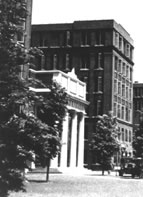Mission and History
Mission
The Flaum Eye Institute will garner and maintain a position of leadership in ophthalmology and vision science by applying the principles of continuous learning and by developing internal collaborations as well as productive external partnerships.
Strong Leaders

In 1929, The University of Rochester Institute of Optics was established as the first academic optical center in the world.
In 1964, the Center for Visual Science was created as an inter-departmental research and teaching program. It has grown into one of the most prominent visual science institutions in the world, renowned for the collaborative spirit that drives its research advances.
The Flaum Eye Institute represents the next evolution in our quest to be a world leader in eye health.
Strong Memorial Hospital, one of the premier medical centers in the country, opened in 1926. Dr. Albert Conrad Snell, Sr., organized the Division of Ophthalmology in 1929. Dr. Snell achieved international recognition for his pioneering work in industrial ophthalmology and routine screening of school-age children. He also organized the first graduate course in ophthalmology, held in 1930.
The featured faculty included many of the great figures in American ophthalmology, including Drs. Reese, Adler, Lancaster, Verhoff, Spaeth, Berens, Wilmer, and Walsh.
Dr. John Fried Gipner held the Chair of the Division of Ophthalmology from 1931-1961, after which Albert Conrad Snell, Jr. became chair until his retirement Dr. Henry Metz was appointed Chair of the newly created Department of Ophthalmology in 1978 and he served in the position until 1993. Under Dr. Metz, Dr. Seymour Zigman elucidated the dilatory effects of ultraviolet light on the eye.
Steven Ching, MD, became interim Chair until the appointment of Dr. George Bresnick as Chair in 1994. During his tenure, Dr. Bresnick started Project Eye Care, greatly expanding the Department's commitment and effort to provide eye care to the disadvantaged in the Rochester area.
Concurrently, Dr. Manuel del Cerro did groundbreaking work on embryonic retinal tissue transplantation. After George Bresnick's departure in 1997, Dr. Barrett Katz became interim chair until 1999, when Dr. Ching again assumed the interim position. During this period, he recruited Dr. Scott MacRae, an internationally acclaimed clinician and researcher in the burgeoning field of refractive surgery.
In 2001, Dr. Steven Feldon became Chair and began work to create the Flaum Eye Institute. He launched an aggressive recruitment effort, moving from eight faculty members to more than 45 full- and part-time physicians and scientists to accommodate expansion of clinical, research and training programs. Today, the Institute is currently ranked in the Top 25 for National Institutes of Health research funding, has 70,000 yearly patient visits and has a growing residency training program that competes among those in the upper echelons of ophthalmology.
In 2019, FEI retina specialist and graduate of the University of Rochester's MD, PhD Program, David DiLoreto assumed the chair, poised to lead FEI through its next phase of growth.
Rochester—A Center For Excellence
It's not accidental that the University of Rochester has excelled in the imaging and medical sciences. George Eastman, founder of Eastman Kodak, heavily endowed these areas to ensure access to the healthiest, best trained work force anywhere. Eastman’s legacy has been carried on by a string of global industries, founded and centered in Rochester and the Upstate environs. These include household names such as:
- Xerox Corporation
- Bausch & Lomb, Inc.
- Corning Glass
- The Reichart division of Leica
- Welch Allyn, Inc.
All depend upon, and, therefore, support relevant sciences at the University of Rochester. Within the Department of Ophthalmology, there is local industrial support for studies on: